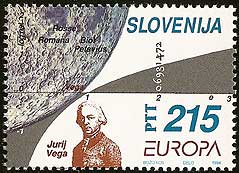
Father
Antonio Romañá Pujó, SJ |


SLOVENIA, 1994, a Europa issue honoring discoveries and inventions, Scott
195
The above stamp makes primary reference to Baron Jurij Vega and includes part of the moon's surface with the Vega crater named for him. But also on the moon are the names of four other scientists for whom lunar craters were named: Jean-Baptiste Biot (1774-1862) French mathematician and physicist; William Parsons, Earl of Rosse (1800-1867) builder of the largest telescope of his time; and two Jesuits: Fr. Denis Pétau, SJ (Dionysius Petavius) well-known French theologian (1583-1652) and the Spaniard astronomer Fr. Antonio Romañá Pujó, SJ (1900-1981).
At least 35 craters are now named in honor of Jesuits. Conflicts arose over the centuries because the naming process was not standardized. The International Astronomical Union (IAU), formed in 1922, eliminated these conflicts and in the process dropped 5 of 40 Jesuit names. Petavius (Pétau) survived, but Romana was dropped. The crater named for him, however, is found on the 1960 Wilkins' Map of the Moon and on the above stamp.
Fr. Antonio Romañá Pujó, astronomer and mathematician, was born in Barcelona on 21 March 1900, and died in San Cugat of the Vallés (Barcelona) October 13, 1981. After getting his licentiate and doctorate, he worked in the Ebro Observatory at Roquetas (Tarragona) from 1934 to his death, and was its director from 1939 to 1971. He was the first president of the UGGI (International Union of Geodesy and Geophysics). He published more than 150 studies, the majority on the Earth-Sun relationship. He was the ideal priest-scientist who maintained fidelity to both Church and science in a healthy synthesis.
While Romañá lost his title to a lunar crater, asteroid 19783 was named Antoniromanya by its discoverer, Jaume Nomen, to honor this Catalan Jesuit. It was first seen November 14, 1990 at the Crimea observatory, observed again in 1998 from New Mexico, and a sighting on August 27, 2000 from Ametlla de Mar permitted an exact determination of its orbit. It is 14.4 kilometers in diameter and is in a stable and permanent orbit in the asteroid belt between Mars and Jupiter.